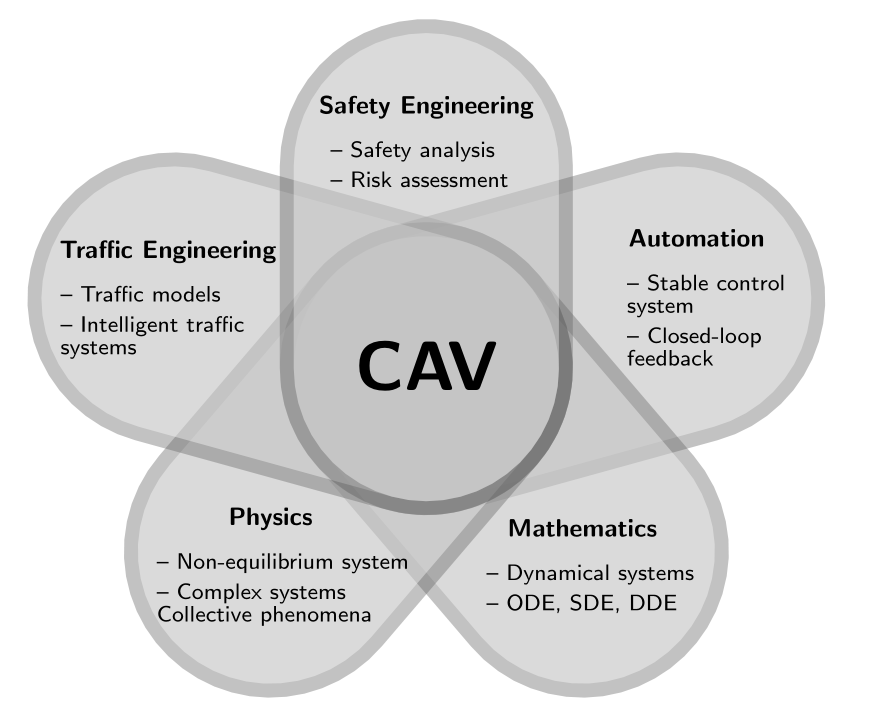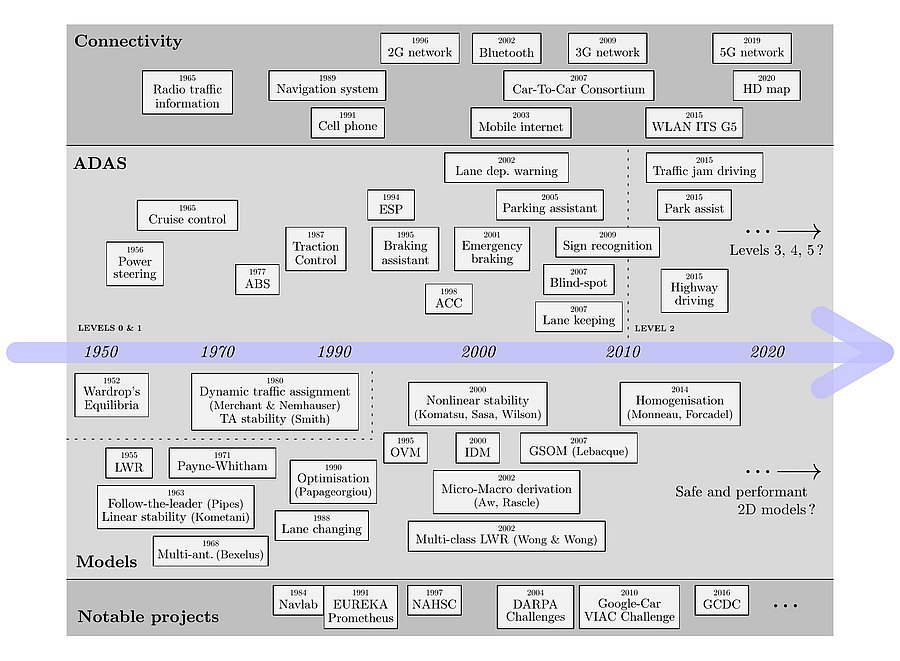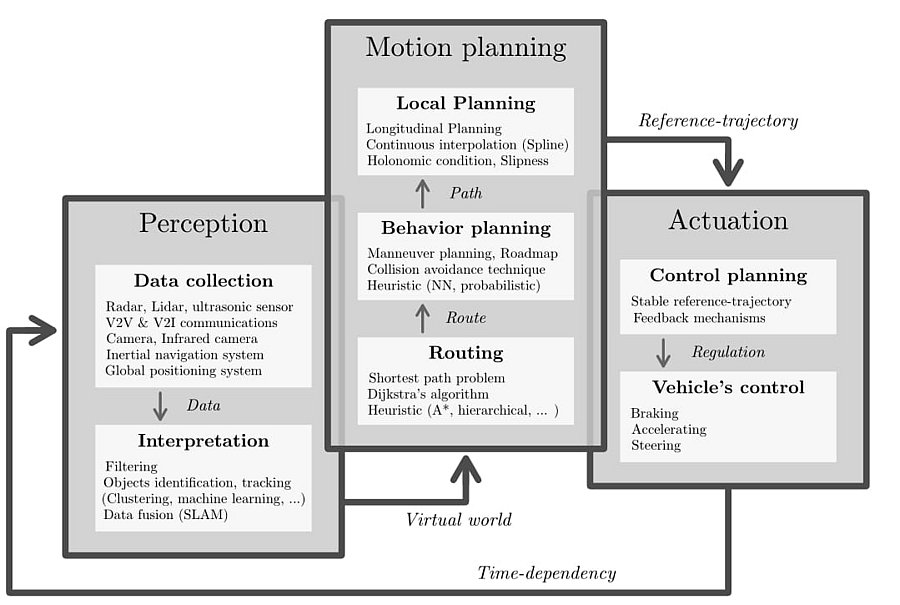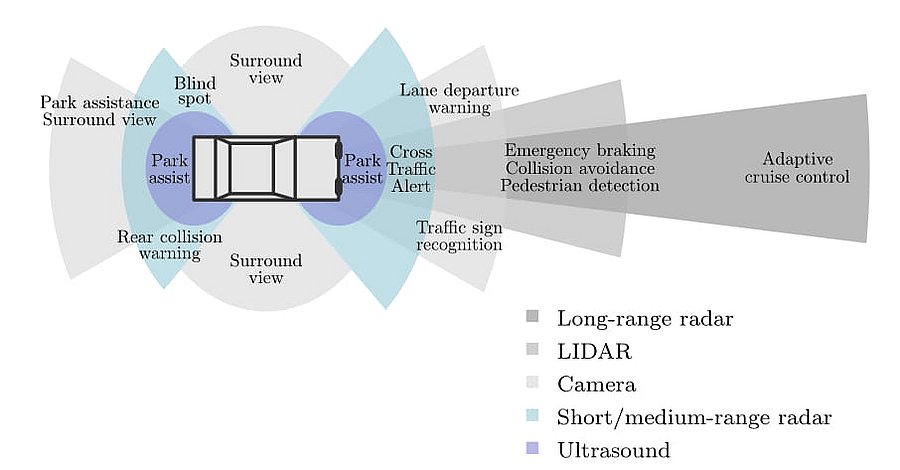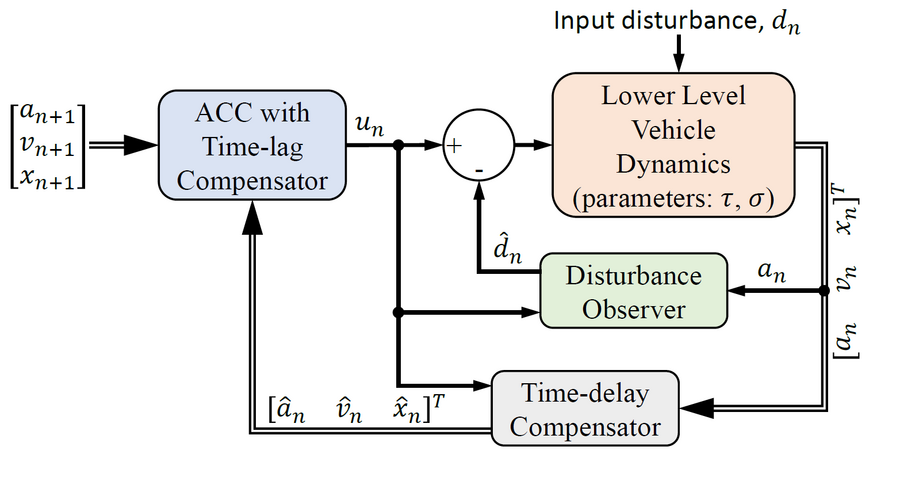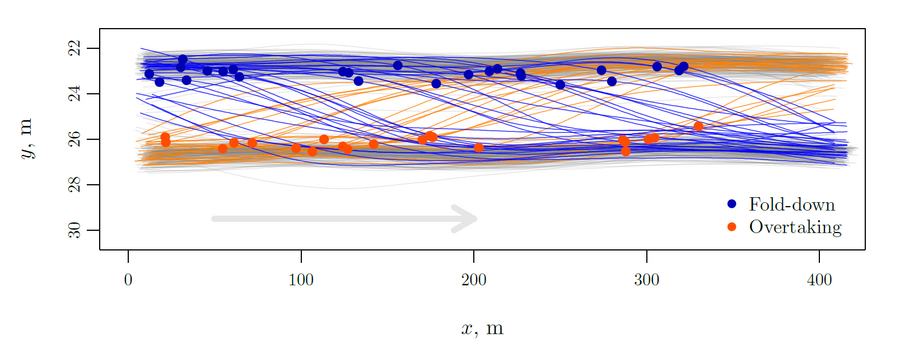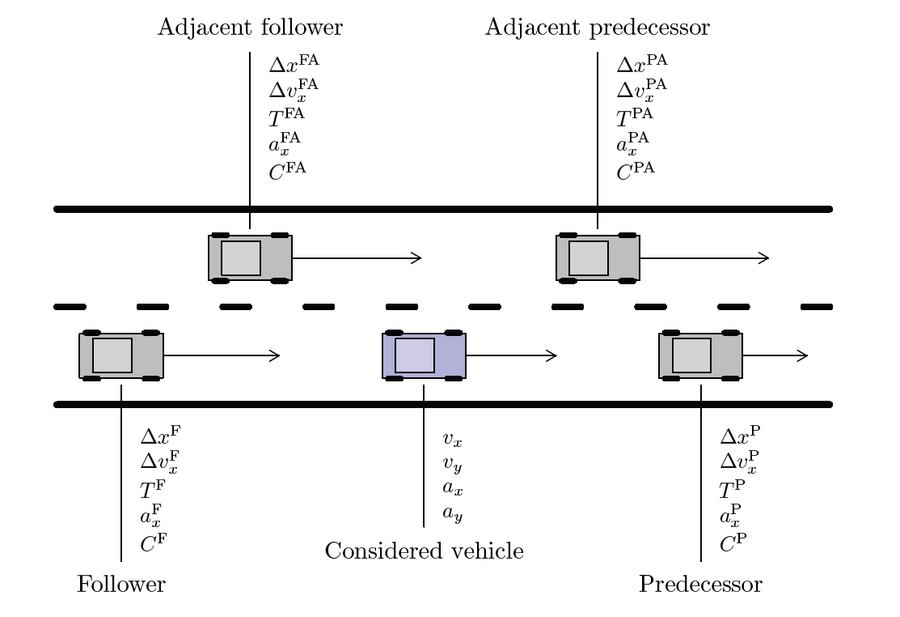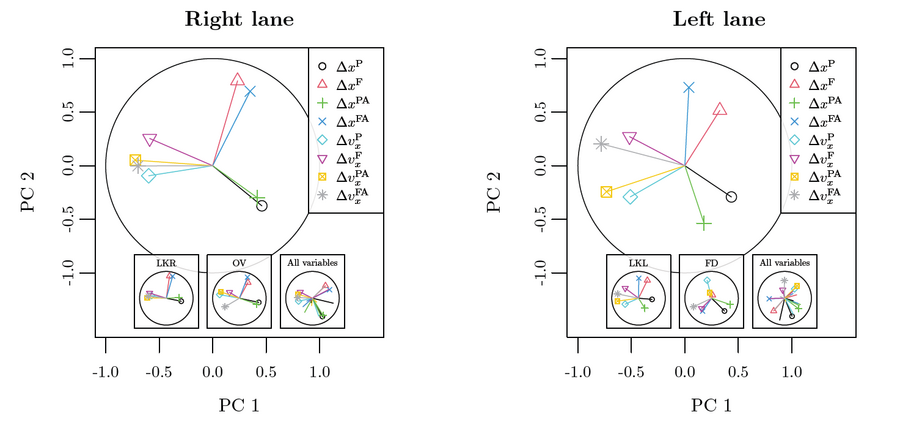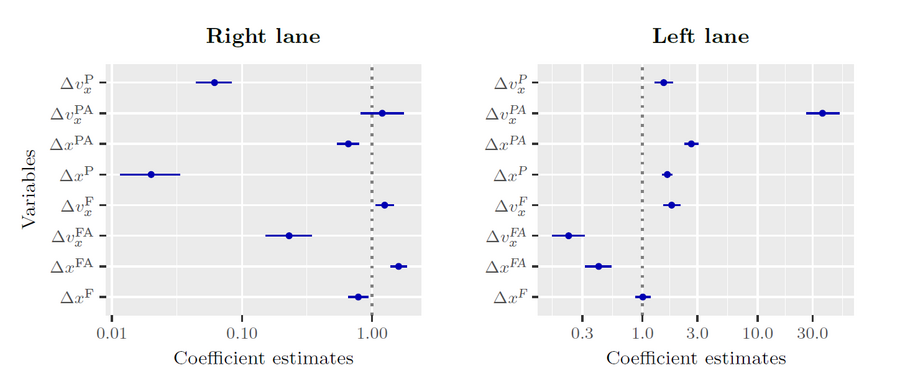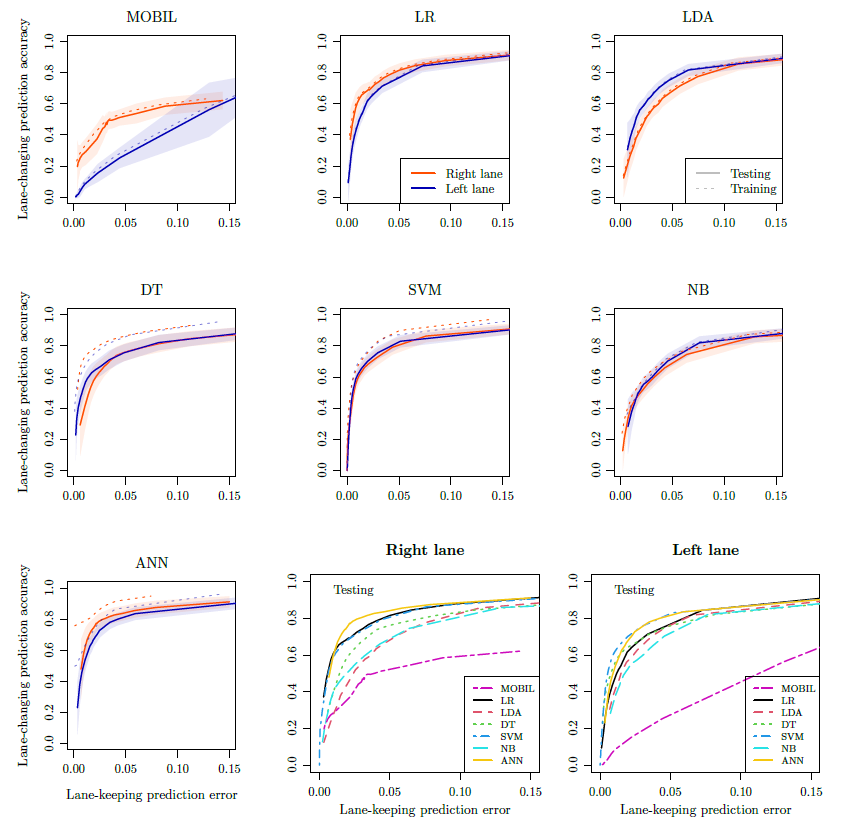Connected and autonomous vehicle
Road vehicles are becoming increasingly automated. Sensors and Advanced Driver Assistance Systems (ADAS) are common equipment of modern cars, while Connected and Automated Vehicles (CAV) are currently actively developed by automobile companies and suppliers, research centers, universities, and standardisation organizations. One of the main arguments for driving automation lies in safety aspects. Indeed, most accidents are due to human errors that could be avoided with safe automated systems.
Functional architecture of automated vehicles
The architecture of automated driving systems is mission-based. It mainly consists of three components:
1. The perception phase, when the system measures the surrounding thanks to sensors and cameras and interpret the driving situation.
2. The motion planning phase, when the system determines for the driving situation a safe, comfortable, and performant reference trajectory to follow.
3. The actuation phase for the longitudinal and lateral control of the vehicle to the reference trajectory.
Functional safety analysis
Quantitative functional safety analysis of the automatised driving systems is necessary to evaluate and demonstrate their reliability and safety. However, automated driving is a dynamic process having a complex functional architecture, and the driving situations are various. Classical static approaches (see the ISO Norm 26262:2018 for functional safety of road vehicles) consist of exhaustive analysis with corresponding risk evaluation for all driving situations and vehicle items. Such a task is not realisable for automated driving, especially for urban traffic at levels 3, 4, or 5 of automation without supervision. Indeed, the system and no more the driver is responsible in case of hazards at these automation levels. There is currently an important development of specific tools and methods for the safety of automated vehicles able to take into account the varied dynamical aspects of the driving situations (see also ISO/PAS 21448:2022 standard for the safety of the intended functionality of road vehicles). Further references to the safety of autonomous and connected vehicles can be found in these presentations Pres1, Pres2 (in English), and Pres3 (in German).
Adaptive cruise control system
Many recent experiences show that adaptive cruise control (ACC) systems currently available on the market describe unstable behaviors. Single-file motions present perturbation amplification resulting in the formation of shock waves and stop-and-go. Such phenomena are observed with human-driven vehicles as well. Some studies even suggest that the traffic flow instability is worst with the driving automation systems, especially for performance (sport) modus. One of the reasons is the important system response times to the modification of the environment, resulting from perception, computation, and mechanical latencies, among other filtering and smoothing effect. Indeed, ACC system response times are generally estimated by 1 to 2 seconds, while the human reaction time is around 0.5 second for attentive drivers and 1 second for inattentive ones. Such estimates are not compatible with norm requirements of ACC systems (ISO Norm 15622:2018).
Making ACC systems stable and robust represents currently an important research and industrial challenge. Some techniques are based on temporal and spatial anticipation mechanisms. The anticipative systems generally rely on the dynamics of further predecessors ahead, or even of predecessors. They are well established in the literature under the terminology cooperative cruise control system (CACC). They require communication equipment between the vehicles. The presence of noise in the dynamics is a second factor that leads to wave effects with periodic dynamics. Such phenomena rely on specific noise features. The concept is currently actively developed in the literature (see the paragraph about noise-induced stop-and-go wave).
Lane-change prediction
The prediction of lane-changing maneuvers on the highway according to the dynamics of the surrounding vehicles is a challenging task. Indeed the decision of a driver to change lanes is motivated by many factors relying on safety, comfort, or performance aspects. An exhaustive listing of all the driving situations resulting in a lane-changing maneuver is laborious, especially on European highways for which the traffic regulations recommend keeping the right lane. This makes the lane-changing decision-making from the left to the right lane, and inversely, asymmetric.
Classical rule-based lane-changing models rely on predictions of acceleration or speed gain by undertaking a lane change. The rule consists of choosing to change the lane as a combination of politeness/safety and performance factors exceed a critical threshold. Such types of rules are generally too simplistic to cover all the possible driving situations resulting in a lane-changing maneuver. Recent approaches are data-driven algorithms based on classification statistical models such as logistic or discriminant regressions, or machine learning techniques, e.g., support vector machines, neural networks, or random forests. Deep learning techniques taking as inputs time-sequences instead of the instantaneous state of the environment show high accuracy. On the modelling side, hidden Markov models also present accurate predictions, much more precise than rule-based models. The most recent approaches rely on ensemble learning meta-heuristics combining different prediction algorithms (e.g., Stacking or Boosting methods).
- B. Khelfa, I. Ba and A. Tordeux, "Predicting highway lane-changing maneuvers: A benchmark analysis of machine and ensemble learning algorithms", Physica A: Statistical Mechanics and its Applications, vol. 612, pp. 128471, 2023.
- P. Khound, P. Will, A. Tordeux and F. Gronwald, "The Over-Damped String Stability Condition for a Platooning System", System Theory, Control and Computing Journal, vol. 3, no. 1, pp. 12-19, 2023.
- P. Khound, P. Will, A. Tordeux and F. Gronwald, "Unified framework for over-damped string stable adaptive cruise control systems", Transportation Research Part C: Emerging Technologies, vol. 148, pp. 104039, 2023. Elsevier.
- B. Khelfa, R. Korbmacher, A. Schadschneider and A. Tordeux, "Heterogeneity-induced lane and band formation in self-driven particle systems", Scientific Reports, vol. 12, no. 1, pp. 1-11, 2022. Nature Publishing Group.
- P. Khound, P. Will, A. Tordeux and F. Gronwald, "The importance of the over-damped string stability criterion for a platooning control system" in 2022 26th IEEE International Conference on System Theory, Control and Computing (ICSTCC), 2022, pp. 1-6.
- P. Khound, P. Will, A. Tordeux and F. Gronwald, "Extending the adaptive time gap car-following model to enhance local and string stability for adaptive cruise control systems", Journal of Intelligent Transportation Systems, vol. 27, pp. 36-56, 2021. Taylor & Francis.
- I. Ba and A. Tordeux, "Comparing Macroscopic First Order Models of Regulated and Unregulated Road Traffic Intersections" in Proceeding of 30th European Safety and Reliability (ESREL) Conference, 2021.
- B. Khelfa and A. Tordeux, "Comparing rule-based and data-based approaches for lane-change prediction" in Proceeding of 30th European Safety and Reliability (ESREL) Conference, 2021.
- B. Khelfa and A. Tordeux, "Lane-changing prediction in highway: Comparing empirically rule-based model MOBIL and a naive Bayes algorithm" in 2021 IEEE International Intelligent Transportation Systems Conference (ITSC), 2021, pp. 1598-1603.
- B. Khelfa and A. Tordeux, "Understanding and Predicting Overtaking and Fold-Down Lane-Changing Maneuvers on European Highways Using Naturalistic Road User Data" in 2021 IEEE Intelligent Vehicles Symposium Workshops (IV Workshops), 2021, pp. 168-173.
- B. Khelfa and A. Tordeux, "Extended Longitudinal Motion Planning for Autonomous Vehicles on Highways Including Lane Changing Prediction" in Traffic and Granular Flow 2019, Springer, 2020, pp. 495-503.
- A. Tordeux, J. Lebacque and S. Lassarre, "Robustness analysis of car-following models for full speed range ACC systems" in Traffic and Granular Flow 2019, Springer, 2020, pp. 571-581.
- A. Tordeux and B. Khelfa, "Dynamic Safety Analysis of Longitudinal Motion Planning for Autonomous Vehicles" in Proceeding of 29th European Safety and Reliability (ESREL) Conference, 2020.

